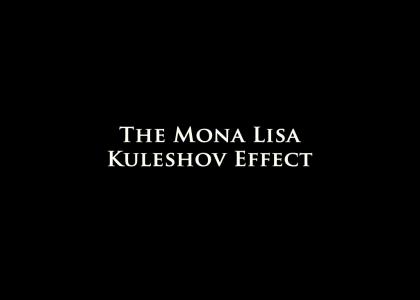The Mona Lisa Kuleshov Effect (no sound)
Created on: January 26th, 2008

This is a conscious attempt on my part to start a Kuleshov Effect craze. I thought about who to start with, and then I thought of The Mona Lisa. The woman with the most talked-about smile (what is she thinking?) in history. And I knew I had to use her.
Sponsorships:
| user | amount | user | amount |
|---|---|---|---|
| No one has sponsored this site ( ._.) | |||
| Sponsor this site! | Total: $0.00 | Active: $0.00 | |
Vote metrics:
| rating | total votes | favorites | comments |
|---|---|---|---|
| (3) | 7 | 0 | 16 |
View metrics:
| today | yesterday | this week | this month | all time |
|---|---|---|---|---|
| 0 | 0 | 0 | 0 | 1,489 |
Inbound links:
| views | url |
|---|---|
| 43 | https://www.bing.com |
| 8 | http://www.google.com.hk |
| 4 | http://216.18.188.175:80 |
| 1 | http://www.google.com.tr/search?q=Lisa+Kuleshov&oq=Lisa+Kuleshov |
| 1 | http://www.google.com |
montage effect demonstrated by Russian filmmaker Lev Kuleshov in about 1918.
Kuleshov edited a short film in which shots of the face of Ivan Mozzhukhin (a Tsarist matinee idol) are alternated with various other shots (a plate of soup, a girl, an old woman's coffin). The film was shown to an audience who believed that the expression on Mozzhukhin's face was different each time he appeared, depending on whether he was "looking at" the plate of soup, the girl, or the coffin, showing an expression of hunger,
, desire or grief respectively. Actually the footage of Mozzhukhin was identical, and rather expressionless, every time it appeared. Vsevolod Pudovkin (who later claimed to have been the co-creator of the experiment) described in 1929 how the audience "raved about the acting.... the heavy pensiveness of his mood over the forgotten soup, were touched and moved by the deep sorrow with which he looked on the dead woman, and admired the light, happy smile with which he surveyed the girl at play. But we knew tha
But we knew that in all three cases the face was exactly the same." [Pudovkin, "Naturshchik vmesto aktera", in Sobranie sochinenii, volume I, Moscow: 1974, p.184].
Kuleshov used the experiment to indicate the usefulness and effectiveness of film editing. The implication is that viewers brought their own emotional reactions to this sequence of images, and then moreover attributed those reactions to the actor, investing his impassive face with their own feelings.
Kuleshov demonstrated the necessity of considering montage as the basic tool of cinema art. In Kuleshov's view, the cinema consists of fragments and the assembly of those fragments, the assembly of elements which in reality are distinct. It is therefore not the content of the images in a film which is important, but their combination. The raw materials of such an art work need not be original, but are pre-fabricated elements which can be deconstructed and re-assembled by the artist into new juxtapositions.
And credits.
Leonardo - The Mona Lisa
Michaelangelo - The David
William Adolphe Bouguereau - The Birth of Venus
Titian - Tarquin and Lucretia
Artemisia Gentileschi - Judith Beheading Holofernes
Dieric Bouts the Elder - The Fall of the Damned
Christ Pantocrator from St. Catherine's Monastery in the Sinai
Pieter Aertsen - The Adoration of the Magi
Sandro Botticelli - Primavera
No, I didn't know what the Kuleshov Effect was when I saw this site. You can't use a static image for the repeating portion of the video, because otherwise the people watching it aren't looking at an actor, they're looking at a photo. There has to be some motion to convey the emotion. The fact that I knew beforehand that the Mona Lisa doesn't move ruined the effect even more.
Bold
Italic
Underline
Code
User Link
Site Link